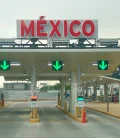Understanding the Letter of Permission to Drive a Vehicle in Mexico: A Complete Guide
By Rocio Morales |

Planning a road trip to Mexico? Whether it’s a beach getaway in Baja, a cultural adventure in Oaxaca, or a quick trip to visit family just past the border, driving can give you the freedom to explore Mexico at your own pace.
In order to drive a vehicle across the border, one document you’ll need is the vehicle’s registration. And if the vehicle you’re taking isn’t registered in your name—maybe it’s your friend’s pickup, a company car, or even your spouse’s SUV—you’ll also need an extra document: a letter of permission to drive a vehicle in Mexico.
This isn’t just a formality. Customs officials, Banjercito representatives, and even police checkpoints may ask for it to verify that you have legal authorization to drive the car. Without it, your trip could hit a serious speed bump.
Let’s break down what this letter is, when you need it, how to write one, and what happens if you don’t have it. By the end of this guide, you’ll feel confident crossing the border—no surprises, no stress.
Remember, before you hit the road, there’s one crucial detail many travelers overlook: you’ll need Mexican car insurance—U.S. policies aren’t valid across the border.
What Is a Letter of Permission to Drive in Mexico?
A letter of permission to drive in Mexico (sometimes called a Mexican customs vehicle letter or car owner authorization) is a simple but crucial document. It’s basically written proof that the owner of a vehicle has granted you permission to take that vehicle into Mexico.
It’s often required when applying for a Temporary Import Permit (TIP)—a document issued by Banjercito that allows foreign vehicles to travel beyond the Free Zone (roughly 20–25 km past the border) and guarantees the return of the vehicle to its place of origin.
If you think of the TIP as your car’s “visa,” then the Mexico vehicle permission letter is your proof of ownership rights—or in this case, “borrowing rights.”
When Do You Need a Permission Letter?
You’ll need a letter of permission to drive in Mexico if:
- The car you’re driving is not in your name, such as a friend’s or family member’s vehicle.
- You’re using a company vehicle or leased car.
If you’re just taking a quick shopping or dining trip to Tijuana, Nogales, or another border town, you may not need the letter or the TIP. But for anything deeper into Mexico—say, a drive to Guadalajara, Mazatlán, or San Miguel de Allende—you’ll want to make sure your paperwork is in order.
Who Is Required to Present One?
Anyone driving a vehicle they don’t own could be asked to show a permission letter for car in Mexico. That includes:
- Borrowing your parents’ truck for a fishing trip.
- Taking your spouse’s car on a solo drive to visit friends.
- Driving your company vehicle for business or vacation.
- Financed Vehicles.
If your name isn’t on the registration, assume you’ll need authorization. It’s always better to have the letter ready than to be turned around at the border.
Legal Requirements for Driving a Vehicle in Mexico
If you’re planning a road trip to Mexico, it’s important to understand the legal requirements for driving there. Mexico takes vehicle documentation seriously, and you’ll need to carry:
- A valid driver’s license (you must be at least 18—the legal driving age in Mexico).
- A passport or FMM (tourist card).
- The car’s registration/proof of ownership.
- Mexican auto insurance—U.S. or Canadian policies don’t count here.
- If traveling beyond the Free Zone, a TIP.
- And finally, your Mexico car permission letter if you’re driving someone else’s car.
Having these documents not only keeps you compliant but also makes any interactions with police or customs officers much smoother.
How to Write a Valid Permission Letter
A Mexico car permission letter doesn’t have to be complicated, but it does have to include certain key details. Think of it as a formal note from the car’s owner that says, “Yes, this person has my full permission to take my vehicle into Mexico.”
Here’s what to include:
- Owner’s Information: Full name, address, and contact details.
- Driver’s Information: Full name, passport number, and driver’s license number.
- Vehicle Details: Year, make, model, VIN, color, and license plate number.
- Travel Details: Where and when the vehicle will travel in Mexico.
- Authorization Statement: A clear statement granting permission to operate the vehicle in Mexico.
- Owner’s Signature: Signed and dated, ideally with a printed name beneath.
- Notarization: To confirm authenticity.
It’s a good idea to prepare the letter in both English and Spanish. That way, officials on either side of the border can read it easily.
Does the Letter Need to Be Notarized?
While it’s possible some border agents may accept a signed letter, it is always recommended for it to be notarized—especially when applying for a Banjercito temporary importation permit or if you are stopped by authorities.
A notary’s stamp confirms the signature is legitimate, which prevents fraud and speeds up the approval process. You can get this done at a local notary public before your trip—it only takes a few minutes and can save you a major headache later.

Special Scenarios That Require Extra Attention
Here’s where things can get a little tricky—different ownership situations come with unique rules, so it’s worth double-checking your case and knowing what to bring when crossing the border to avoid any last-minute surprises.
Special Scenario 1: Leased or Financed Vehicles
If your car is leased or financed, contact your lender ahead of time, it can take several days before you receive it. They’ll usually give you a notarized letter granting permission to drive into Mexico.
Special Scenario 2: Rental Cars
Most U.S. rental agencies don’t allow their cars across the border, but a few near-border locations do, and they will give you the notarized letter of permission at the counter. Always confirm that your rental includes Mexican coverage before you hit the road.
Special Scenario 3: Company Vehicles
If it’s a company car, get written permission on official company letterhead from an authorized representative.
Special Scenario 4: Family-Owned Vehicles
Even if the car belongs to your spouse or sibling, you still need a notarized Letter of Permission to Drive the vehicle in Mexico, if the registration isn’t in your name.
No matter what the scenario is, bring your original current registration, ownership papers, and permission letter to keep things smooth at the border.
In all of these cases, bring two copies of supporting documents, like registration or ownership papers, and passport along with your letter.
How to Obtain the Letter of Permission
Getting your Letter of Permission for Mexican customs is a straightforward process if you follow a few simple steps. Start by asking the vehicle owner for permission and sharing your travel plans, including your dates and destinations. Next, draft the letter, making sure it includes all the required details—like the vehicle’s information, your name, and the owner’s consent.
Once it’s ready, have it notarized by a local notary to make it official. It’s a good idea to print extra copies, keeping the original and a few photocopies on hand since officials may need to keep one. Finally, present the letter at Banjercito when applying for your Temporary Import Permit (TIP); it serves as your proof that you’re authorized to bring the vehicle into Mexico.
Tip: Keep your documents neatly organized in a travel folder. Having everything accessible can make border crossings much smoother.
Consequences of Driving Without a Letter of Permission
It might be tempting to skip the letter and hope for the best—but that’s a risk you don’t want to take. If you drive someone else’s car in Mexico without proper authorization, you could be denied entry at the border, face vehicle impoundment or fines, or experience delays getting your Temporary Import Permit (TIP) and even trouble returning to the U.S.
In more serious cases, you might encounter legal penalties if you’re stopped and can’t prove ownership. In short, skipping the letter can quickly turn your vacation into a bureaucratic headache—so it’s always better to play it safe and have the proper documentation ready.
Get Mexican Auto Insurance Before You Cross the Border!
Even with the right documents, no trip to Mexico is complete without Mexican auto insurance. Your U.S. or Canadian policy won’t protect you once you cross the border—and if you’re in an accident, you could be held personally liable for damages.
At Sanborn’s Mexico Auto Insurance, we’ve been helping travelers drive confidently in Mexico for over 75 years. Whether you need a one-day policy or long-term coverage, we’ll make sure you’re legally protected and fully insured. Before you hit the road, You can purchase insurance online, call 800‑222‑0158, or visit one of their locations along the border. Safe travels!
Frequently Asked Questions
What Should I Do If I Forget to Obtain a Permission Letter?
If you realize at the border that you forgot your letter, you’ll likely be turned back. Contact the vehicle owner immediately and have them send a notarized copy by email or courier before attempting again.
Is It Possible to Drive a Rented Car to Mexico Without a Permission Letter?
Most rental contracts in the U.S. prohibit driving into Mexico. However, some border rental companies partner with Mexican insurers and can provide all required paperwork and coverage. Always confirm in writing before you book.
How Can I Verify My Letter of Permission Is Compliant with Mexican Laws?
Double-check that it’s notarized, lists all vehicle details (VIN, plate, model, etc.), and includes both your and the owner’s full names and IDs. For extra assurance, contact Banjercito or your nearest Mexican consulate before your trip.

